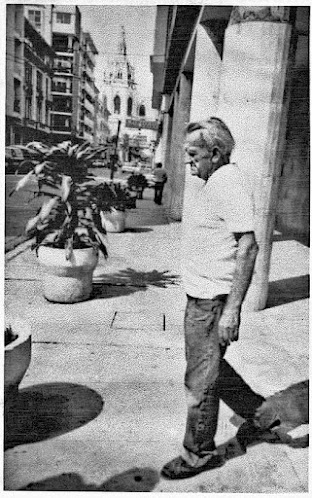 |
Machu Picchu. A favorite place in my travels, Alicia Graham © 2005
|
In
this Grand Tour post, the description of the trip as written in 1967 may be read in the "South
American Trip Diary". The 12 pages of
that document may be found below.
Each Peace Corps
Volunteer received two paid vacation days per month of service. Many
volunteers used a major portion of this time to travel to nearby
countries. My South American Grand Tour took 30 of these days
(September 15, 1967 to October 15, 1967). Most of the trip was traveled
with a fellow volunteer from my group.
South American Trip Diary
 |
| Pages 3-4, Cusco and Machu Picchu |
|
 |
Pages 1-2, Lima and Cusco
|
 |
| Pages 7-8, La Paz, Såo Paulo, Rio |
|
|
 |
| Pages 5-6, Machu Picchu, Boat-Train & La Paz |
 |
Pages 11-12, Santiago, the desert, home
|
 |
Pages 9-10, Montevideo, Bueno Aires, Mendoza
|
Three maps are included to provide a better sense to readers not familiar with the continent. A quick overview of my travels may be found in the image to the left. A more detailed view is contained in two maps; the first of the Andean portion of the trip and the second of the remainder.
Supplementing the written pages, photos of places traveled to and through on this trip are included. To satisfy the curious about changes in the subsequent decades, I am including photos from the 1960s and more recent times. In the following years I both traveled to Ecuador (2007) and Brazil (2012) and a daughter in 2005 traveled on the Inca trail to Machu Picchu, my favorite discovery on the 1967 trip..
 |
Showing the route through the Andes of the first part of South American Tour,
Map courtesy of Wikipedia |
Lima
These
two photos are current images of Lima, Peru. I seem to have taken no
pictures of the city on the trip. With an average yearly rainfall of
18.2 mm, Lima is a desert city. Strangely, despite the aridity, Lima has
overcast skies much of the year. It seems that cloudy skies does not
guarantee rainfall. Lima is Peru's capital city, with a metropolitan
population of 10 million people.
 |
Coastal Lima
|
 |
Central Lima
|
Cuzco
As our Faucett Airlines plane neared Cuzco, I was mesmerized by the window view of range after range of glacier covered mountains as we neared our destination. Cuzco is located in a broad valley at over 11,000 feet in elevation. Its population is a little over 400,000 persons. Before the arrival of the Spanish conquistadores, it was the capital of the Inca Empire, the "Roman Empire" of the Americas.
 |
Glacier covered mountain wall west of Cuzco
|
 |
| Historic section of Cuzco |
 |
Llama and woman resting on Cuzco sidewalk
|
 |
Sacsayhuaman, Inca fortress overlooking Cuzco
|
Machu Picchu
Machu Picchu remained a "hidden" Inca citadel for 400 years. In 1911 American explorer Hiram Bingham reached the site and brought it to international attention. Most archaeologists believe that Machu Picchu was constructed prior to the Spanish conquest as an estate for the Inca emperor Pachacuti (1438–1472).
It is located about 80 kilometers northwest of Cuzco in the Eastern Cordillera of southern Peru, on a mountain ridge about 2,400 meters (8,000') high. A canyon cut through the Cordillera by the Urubamba River lies below it.
The image on the right illustrates the fine quality stonework customary with the Incas
 |
Illustration of steep terrain upon which
the citadel was constructed |
 |
Close up of the terraces constructed to hold fertile
soil transported up from river in canyon below |
Lake Titicaca
The next objective for my tour of the South American continent was La Paz, Bolivia. Our mode of transport for that travel segment was a boat-train across Lake Titicaca which is shared between Peru and Bolivia.
The daylight portions of this trip leg would occur in two trains. The night would be on the boat crossing the lake. The travel modes would include a train from Cuzco to the lake, a boat ride across the lake, and the Bolivian train from the lake to La Paz. The total distance is about 500 miles.
 |
On the shores of Lake Titicaca
|
 |
The SS Olanta, which I believe was our ferry across
the lake
|
La Paz
The Altiplano is a plateau at an elevation of about 3500 meters, with scattered mountains located on its surface above that height. Most of the altiplano is located in Bolivia. The rest may be found primarily in Peru, with a southern extension in Argentina and Chile. Only in Tibet is there a plateau of this size and height on the planet.
The section between Lake Titicaca and La Paz is flat. The eastern edge of the plateau drops off sharply in a significant escarpment. La Paz is located at the bottom of that escarpment where it appears a chunk was bit out of the edge of the Altiplano.
 |
High rises of central La Paz come into view as
the train continues its descent.
|
 |
The beginning of the train's descent to La Paz.
Note the almost flat altiplano just below the higher
mountain peaks. Alicia Graham © 2005
|




























